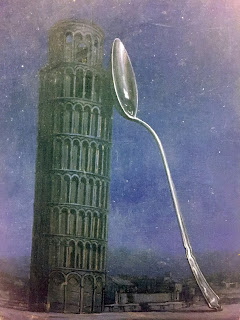 |
1928-9
Words and images
Blue ink, Indian Ink, collage, pencil on paper |
Although widely known as a Surrealist artist, Rene Magritte's works were far from the term. Born in Belgium in 1819, Magritte lived a middle class lifestyle, however after his mother committed suicide in 1912, his childhood was forever altered. In 1916 he decided to leave his family and enroll in Academie Royale des Beaux-Arts in Brussels. He then went on to marry Georgette Berger in 1922, a woman he had encountered on several different random occasions. During their marriage, Magritte was employed as a commercial artist in which he designed many ads and posters for clients. He had been influenced by many cubism artists, but in 1923 he discovered "Painting The Song of Love" by Giorgio de Chinco. This mysterious painting would transform Magritte's later works exponentially. He then began in Paris to change his style to Surrealism that invoked senses of confusion from onlookers. Seen to above is a sketch of a work that was influenced by his newfound passion. Included are texts that confuse the viewer. This sketch is thought to have been a preliminary work for La Revolution Surrealiste. Once it was accepted, the drawing changed significantly.
 |
1937
Pencil on tissue paper |
Unfortunately because of the impact of the Great Depression, one of the Paris galleries that held Magritte's work closed. Then after an altercation with a friend, the Magritte's decided to move back to Brussels in 1930. There he worked from his own home office which ultimately lead him to become closer to his works and produced there he created some of his more famous pieces. Although a mere sketch, the drawing on the left shows the interesting imagination of Magritte. It was part of one of his sketchbooks given to a young writer named Marcel Marien. Together they partook in creating thought-invoking drawings. Magritte become relatively successful during his lifetime, but unfortunately passed away from pancreatic cancer August 15th, 1967.
 |
1953
Night in Pisa
Oil on Canvas |
Magritte's artwork is undoubtedly recognizable, however, the meaning behind them doesn't hold quite the same feature. Unlike other Surrealists of the time who painted to evoke a sense of surprise or bizarreness, his used several motifs to create irony and paradoxes that drew the viewers into the image. What set him apart was how his objects seemed to be rearranged nonsensically on the canvas alongside words that seemed irrational. He was said to paint what was in his head rather than what he saw. As his works continued, he strayed away from dissonant motifs to transnational or strange, meaningless objects and worlds that seemed weightless. This is the reason why I choose Magritte. As I flipped through the various accounts of artists, his work popped out to me as confusing yet interesting and led me to inquire more about him. The painting to the right can be seem as an example of his later works with what seems like a weightless environment with a strange object. This was one of the works Alexander Iolas was to buy for his gallery. Many assumed from Magritte's previous works that he would have a feather holding up the tower, but instead he opted for a spoon, further confusing his audience and continuing to doing exactly what he'd been doing all along.
Works Cited
Benesch, E., Draguet, M., Gohr, S., Kuster, U., & Laursen, S. (2005). René Magritte: the key to dreams. Vienna: BA-CA Kunstforum.
a
Whitfield, S. (Ed.). (2012). René Magritte: Newly Discovered Works. Houston: Menil Foundation.



No comments:
Post a Comment